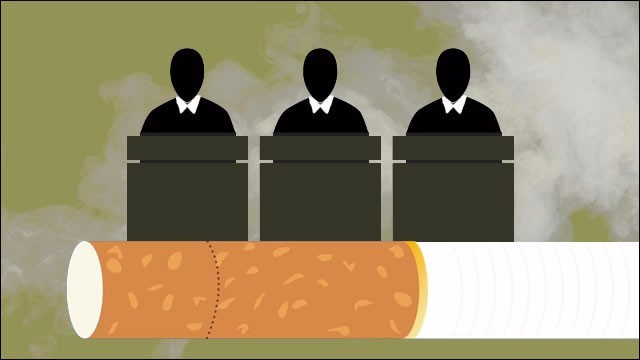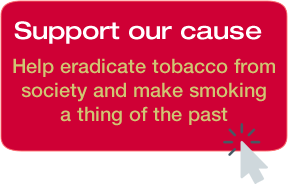Ruling on ‘rigged’ cigarette sought from Administrative Court
12 November 2019

The Netherlands Food and Consumer Product Safety Authority and the Ministry of Health, Welfare and Sport have categorically refused to ban the sale of cigarettes with higher emission values than legally allowed. The Youth Smoking Prevention Foundation (SRPJ), together with the City of Amsterdam and another fourteen parties, has therefore sought a ruling from the Administrative Court in Rotterdam.
Like all consumer products, cigarettes are subject to minimum safety requirements to protect human health. These requirements are detailed in the Dutch Tobacco Act. This Act contains one article that deals with consumer health and seeks to limit the damage caused by the main substances in cigarettes. The article specifies that a cigarette may emit a maximum of 10 milligrams of tar, 1 milligram of nicotine and 10 milligrams of carbon monoxide. The limits of these three substances are referred to by the English acronym ‘TNCO’ limits.
The Act also specifies how emissions from cigarettes must be measured: using a specific method set by international standards, the so-called NEN-ISO standards. All provisions in Dutch legislation are a direct translation of the same provisions in the EU’s Tobacco Products Directive (hereinafter referred to as the Directive).
Legal method unworkable
A 2017 study carried out by the Netherlands National Institute for Public Health (RIVM) — in other words, by the government itself — concluded that the legally prescribed measurement method was unable to determine exact levels inhaled by smokers. This conclusion prompted the lawsuit filed by the SRPJ regarding enforcement of the law, the oral hearing of which took place on Monday 11 November 2019 at 9:30 at the Administrative Court in Rotterdam. The SRPJ is seeking a ruling from the court concerning the fact that the Netherlands Food and Consumer Product Safety Authority (NVWA) employs a method that, although prescribed by law, has been shown by the RIVM to seriously underestimate the actual levels of poisonous substances inhaled by smokers. In truth, smokers inhale two to three times more tar, nicotine and carbon monoxide than legally allowed.
Big difference
The law stipulates that tobacco manufacturers must inform the NVWA every three years of the levels of tar, nicotine and carbon monoxide contained in their cigarettes. The RIVM then uses its own measurements to verify the accuracy of the data received. The results are also sent to the NVWA, which is obliged to enforce the law in the event of violations, for example by imposing a fine or by banning the sale of the cigarettes in question.
In 2018, the RIVM reported that the amounts of TNCO inhaled by smokers were in fact far higher than the legally allowable TNCO maximums of 10 mg tar, 1 mg nicotine and 10 mg carbon monoxide. The differences are very big indeed. The RIVM found that no cigarette remains below the legal limit, and it mostly measured levels of TNCO that were 2 to 3 times higher than legally allowed. The RIVM reached that conclusion by carrying out an additional control measurement, not using the legally prescribed measurement method but another method that, according to experts, including the RIVM, gives a far more accurate indication of what smokers inhale. This is called the Canadian Intense (CI) method.
‘Rigged’ cigarette
The explanation for the striking discrepancy between the measurement results recorded using the legally prescribed ISO method and the CI method is that cigarette filters contain tiny holes that, during tests using the ISO method, add clean air to the smoke ‘inhaled’ by the smoking machine. In reality, however, this dilution of smoke is reduced considerably by smokers themselves, because their lips and fingers block the roles. In measurements using the CI method, the holes in the filter are fully blocked. Because of the holes, therefore, the ISO method prescribed by the Directive does not measure the levels actually inhaled by smokers.
Tobacco manufacturers can vary the number of holes in filters, which means that the industry can precisely determine how much extra tar or nicotine smokers inhale. The greater the number of holes, the greater the dilution, and therefore the higher the amount of nicotine that can be added, as long as the measurement shows that the legal maximums have not been exceeded. You could call that rigging the results. That’s why since the RIVM report came out, people have referred to them as ‘rigged’ cigarettes. Tobacco manufacturers have responded laconically by admitting that the ISO measurement method is in no way intended to measure what smokers actually inhale, but that legislators decided to prescribe that method.
Linear relationship
The consequences for the health of consumers are serious. According to the measurements recorded with the Canadian Intensemethod, the smoke of a cigarette does not contain 10 milligrams of tar, but at least twice that amount. Tar contains countless carcinogenic substances. The SRPJ consulted toxicologist and professor Martin van den Berg, who stated that there is a linear relationship between the levels of carcinogenic substances in cigarettes and the number of tumours they cause. That applies in particular to the prevention of lung cancer. About 20,000 people die each year from the effects of tobacco use, and 13,600 of those die from lung cancer. If the level of tar in cigarettes was a maximum of 10 mg per cigarette instead of at least 20 mg, as shown by the RIVM, that would over time save thousands of people per year from dying of lung cancer.
Sales ban
According to the SRPJ, the law must be enforced using the most accurate data possible concerning what smokers inhale, and the NVWA should therefore enforce the law on the basis of the results measured by the RIVM using the CI method. By not doing so, the NVWA is in fact prioritizing a measurement method found to be demonstrably unreliable, because it is prescribed by law, above protecting the health of consumers by means of the maximum emission levels of poisonous substances, also prescribed by law.
In view of the serious violations revealed by the RIVM, it is obvious that the government must take action. The government must protect consumers, argues the SRPJ, just like it does when it comes to other consumer products in which excessive levels of poisonous substances are found, as for example happened with the Fipronil scandal involving contaminated eggs. The SRPJ has therefore called on the NVWA to enforce the maximum levels of TNCO emissions that, according to the law, smokers may inhale from cigarettes. The SRPJ has also called for a ban on the sale of so-called ‘rigged’ cigarettes.
Health protection
At the centre of the law enforcement case is the fact that enforcement of the legally prescribed maximum levels of tar, nicotine and carbon monoxide is imperative in order to protect public health. The RIVM report has unambiguously found that the legal maximums are greatly exceeded, at least if measured with the CI method. Furthermore, it should be remembered that the RIVM is the only laboratory qualified and legally empowered to carry out these measurements. According to the SRPJ, enforcing the maximum emission levels of poisonous substances to protect public health should prioritize an accurate measurement method above the use of the current legal yet inaccurate measurement method. Those maximum levels have been set to protect public health, which is a civil right, while the measurement requirement is simply a technical requirement, and that should not be prioritized above protecting fundamental rights.
Influence of tobacco industry
In addition, an important issue is that the measurement method prescribed by the Directive was developed by the tobacco industry itself. This state of affairs is in direct opposition to the World Health Organization Framework Convention on Tobacco Control from 2005. Article 5.3 of this convention states that the parties to the convention (among them the Netherlands and the European Union) are obliged to protect their policies with respect to tobacco control from the vested interests of the tobacco industry.
The SRPJ contends that regulation written by the tobacco industry itself (the ISO standards) should never have been incorporated into official legislation. This is all the more reason to prioritize public health in a dispute between legislation to protect health and measurement methods designed by the tobacco industry. After all, health is a civil right that the government has a duty to protect.
Lawsuit in Rotterdam
The NVWA takes the view, however, that the ISO measurement method is prescribed by the EU’s Tobacco Products Directive, even if this does not accurately measure what smokers actually inhale. The NVWA has therefore dismissed the SRPJ’s call to take action, and the State Secretary for Health, Welfare and Sport (VWS) has subsequently declared the objection made by the SRPJ to be unfounded. In response, the SRPJ has sought a ruling from the Administrative Court in Rotterdam. The SRPJ has asked the Court to overrule the decision of the Ministry and to instruct the NVWA to enforce the law on the basis not only of the legally prescribed measurement method but also, for verification purposes, the Canadian Intense method.
The path towards the European court
In case the Court would conclude that it cannot rule in our favour for legal reasons, the SRPJ asks the Court to refer the matter to the European Court of Justice in Luxembourg. In that case, the Court in Rotterdam will have to decide whether a referral to the European Court of Justice is called for.
In such a referral, the Court will put so-called preliminary questions to the European Court of Justice. Those questions concern the explanation and interpretation of European law and, in short, ask whether the European Court of Justice considers that protecting public health is more important than observing a measurement method that has been proven to be unreliable, even though that method is prescribed by the European Directive.
If the Court of Justice reaches that conclusion, the Administrative Court will have to act in accordance with that ruling. If the CI measurement method is then used, as the SRPJ has called for, it would mean that levels of tar in cigarettes will in the long run have to be at least halved, which will prevent thousands of deaths each year from lung cancer.





 Rookpreventie Jeugd is registered as a Public Benefit Organisation.
Rookpreventie Jeugd is registered as a Public Benefit Organisation.